Finding the “Heart” in the Green: Conducting a Bibliometric Analysis to Emphasize the Need for Connecting Emotions with Biophilic Urban Planning
Abstract
:1. Introduction
2. Materials and Methods
2.1. Determining Search Terms and Defining Parameters
2.2. Collecting and Refining Data
2.3. Exporting Data and Determining “Best-Fit” Candidates
2.4. Importing and Visualizing the Data in VOSviewer
3. Results and Discussion
3.1. Thematic Networks
3.2. Geographic Networks
3.3. Authorship/Co-Authorship Networks
3.4. Publication Networks
3.5. Temporal Networks
3.6. Content Analysis
3.7. Limitations
4. Conclusions
Author Contributions
Funding
Institutional Review Board Statement
Informed Consent Statement
Acknowledgments
Conflicts of Interest
References
- Newman, P. Biophilic urbanism: A case study on Singapore. Aust. Plan. 2014, 51, 47–65. [Google Scholar] [CrossRef]
- Beatley, T. Biophilic urbanism: Inviting nature back to our communities and into our lives. William Mary Environ. Law Rev. 2009, 34, 209–238. Available online: https://scholarship.law.wm.edu/wmelpr/vol34/iss1/6 (accessed on 30 March 2021).
- Jorgensen, A.; Gobster, P.H. Shades of green: Measuring the ecology of urban green space in the context of human health and well-being. Nat. Cult. 2010, 5, 338–363. [Google Scholar] [CrossRef]
- Beatley, T.; Newman, P. Biophilic cities are sustainable, resilient cities. Sustainability 2013, 5, 3328–3345. [Google Scholar] [CrossRef] [Green Version]
- Reeve, A.; Desha, C.; Hargreaves, D.; Hargroves, K. Biophilic urbanism: Contributions to holistic urban greening for urban renewal. Smart Sustain. Built Environ. 2015, 4, 215–233. [Google Scholar] [CrossRef] [Green Version]
- Kellert, S. Biophilic urbanism: The potential to transform. Smart Sustain. Built Environ. 2016, 5, 4–8. [Google Scholar] [CrossRef]
- Beatley, T. Biophilic cities and healthy societies. Urban Plan. 2017, 2, 1–4. [Google Scholar] [CrossRef] [Green Version]
- Gillis, K.; Gatersleben, B. A review of psychological literature on the health and wellbeing benefits of biophilic design. Buildings 2015, 5, 948–963. [Google Scholar] [CrossRef] [Green Version]
- Chiesura, A. The role of urban parks for the sustainable city. Landsc. Urban Plan. 2004, 68, 129–138. [Google Scholar] [CrossRef]
- Russo, A.; Cirella, G.T. Modern compact cities: How much greenery do we need? Int. J. Environ. Res. Public Health 2018, 15, 2180. [Google Scholar] [CrossRef] [Green Version]
- Totaforti, S. Emerging biophilic urbanism: The value of the human-nature relationship in urban space. Sustainability 2020, 12, 5487. [Google Scholar] [CrossRef]
- Groenewegen, P.P.; van den Berg, A.E.; de Vries, S.; Verheij, R.A. Vitamin G: Effects of green space on health, well-being, and social safety. BMC Public Health 2006, 6, 149. [Google Scholar] [CrossRef] [PubMed] [Green Version]
- Maas, J.; Verheij, R.A.; Groenewegen, P.P.; de Vries, S.; Spreeuwenberg, P. Green space, urbanity, and health: How strong is the relation? J. Epidemiol. Community Health 2006, 60, 587–592. [Google Scholar] [CrossRef] [PubMed] [Green Version]
- Zhang, J.; Yu, Z.; Zhao, B.; Sun, R.; Vejre, H. Links between green space and public health: A bibliometric review of global research trends and future prospects from 1901 to 2019. Environ. Res. Lett. 2020, 15, 1–17. [Google Scholar] [CrossRef]
- Reyes-Riveros, R.; Altamirano, A.; De La Barrera, F.; Rozas-Vásquez, D.; Vieli, L.; Meli, P. Linking public urban green spaces and human well-being: A systematic review. Urban For. Urban Green. 2021, 61, 1–15. [Google Scholar] [CrossRef]
- Wang, B.; Zhang, Q.; Cui, F. Scientific research on ecosystem services and human well-being: A bibliometric analysis. Ecol. Indic. 2021, 125, 1–9. [Google Scholar] [CrossRef]
- Sharifi, A. Urban sustainability assessment: An overview and bibliometric analysis. Ecol. Indic. 2021, 121, 1–18. [Google Scholar] [CrossRef]
- Daniel, T.C.; Muhar, A.; Arnberger, A.; Aznar, O.; Boyd, J.W.; Chan, K.M.A.; Costanza, R.; Elmqvist, T.; Flint, C.G.; Gobster, P.H.; et al. Contributions of cultural services to the ecosystem services agenda. Proc. Natl. Acad. Sci. USA 2012, 109, 8812–8819. [Google Scholar] [CrossRef] [Green Version]
- Milcu, A.I.; Hanspach, J.; Abson, D.; Fischer, J. Cultural ecosystem services: A literature review and prospects for future research. Ecol. Soc. 2013, 18, 44. [Google Scholar] [CrossRef] [Green Version]
- Roberts, H.; Resch, B.; Sadler, J.; Chapman, L.; Petutschnig, A.; Zimmer, S. Investigating the emotional responses of individuals to urban green space using Twitter data: A critical comparison of three different methods of sentiment analysis. Urban Plan. 2018, 3, 21–33. [Google Scholar] [CrossRef]
- Schwartz, A.J.; Dodds, P.S.; O’Neil-Dunne, J.P.M.; Danforth, C.M.; Ricketts, T.H. Visitors to urban greenspace have higher sentiment and lower negativity on Twitter. People Nat. 2019, 1, 476–485. [Google Scholar] [CrossRef]
- Sim, J.; Miller, P.; Swarup, S. Tweeting the High Line life: A social media lens on urban green spaces. Sustainability 2020, 12, 8895. [Google Scholar] [CrossRef]
- Hood, W.W.; Wilson, C.S. The literature of bibliometrics, scientometrics, and infometrics. Scientometrics 2001, 52, 291–314. [Google Scholar] [CrossRef]
- Munn, Z.; Peters, M.D.J.; Stern, C.; Tufanaru, C.; McArthur, A.; Aromataris, E. Systematic review or scoping review? Guidance for authors when choosing between a systematic or scoping review approach. BMC Med Res. Methodol. 2018, 18, 143. [Google Scholar] [CrossRef]
- Mingers, J.; Leydesdorff, L. A review of theory and practice in scientometrics. Eur. J. Oper. Res. 2015, 246, 1–19. [Google Scholar] [CrossRef] [Green Version]
- Nalau, J.; Verrall, B. Mapping the evolution and current trends in climate change adaptation science. Clim. Risk Manag. 2021, 32, 1–22. [Google Scholar] [CrossRef]
- Steiginga, S.; Evans, I. Finding Open-Access Journals on Scopus Keeps Getting Easier; Elsevier: Amsterdam, The Netherlands; Available online: https://www.elsevier.com/connect/finding-open-access-journals-on-scopus-keeps-getting-easier (accessed on 30 August 2021).
- Mongeon, P.; Paul-Hus, A. The journal coverage of Web of Science and Scopus: A comparative analysis. Scientometrics 2016, 106, 213–228. [Google Scholar] [CrossRef]
- Matsler, A.M.; Meerow, S.; Mell, I.C.; Pavao-Zuckerman, M.A. A “green” chameleon: Exploring the many disciplinary definitions, goals, and forms of “green infrastructure”. Landsc. Urban Plan. 2021, 214, 1–12. [Google Scholar] [CrossRef]
- Kandel, P.; Chettri, N.; Chaudhary, S.; Sharma, P.; Uddin, K. Ecosystem services research trends in the water tower of Asia: A bibliometric analysis from the Hindu Kush Himalaya. Ecol. Indic. 2021, 121, 1–10. [Google Scholar] [CrossRef]
- Carrus, G.; Scopelliti, M.; Lafortezza, R.; Colangelo, G.; Ferrini, F.; Salbitano, F.; Agrimi, M.; Portoghesi, L.; Semenzato, P.; Sanesi, G. Go greener, feel better? The positive effects of biodiversity on the well-being of individuals visiting urban and peri-urban green areas. Landsc. Urban Plan. 2015, 134, 221–228. [Google Scholar] [CrossRef]
- Giannico, V.; Spano, G.; Elia, M.; D’Este, M.; Sanesi, G.; Lafortezza, R. Green spaces, quality of life, and citizen perception in European cities. Environ. Res. 2021, 196, 1–8. [Google Scholar] [CrossRef]
- Krekel, C.; Kolbe, J.; Wüstemann, H. The greener, the happier? The effect of urban land use on residential well-being. Ecol. Econ. 2016, 121, 117–127. [Google Scholar] [CrossRef] [Green Version]
- Santo-Tomás Muro, R.; Sáenz de Tejada Granados, C.; Rodríguez Romero, E.J. Green infrastructures in the peri-urban landscape: Exploring local perception of well-being through “go-alongs” and “semi-structured interviews”. Sustainability 2020, 12, 6836. [Google Scholar] [CrossRef]
- Bengtsson, M. How to plan and perform a qualitative study using content analysis. NursingPlus Open 2016, 2, 8–14. [Google Scholar] [CrossRef] [Green Version]
- Anguelovski, I.; Connolly, J.J.T.; Garcia-Lamarca, M.; Cole, H.; Pearsall, H. New scholarly pathways on green gentrification: What does the urban ‘green turn’ mean and where is it going? Prog. Hum. Geogr. 2019, 43, 1064–1086. [Google Scholar] [CrossRef] [Green Version]
- Cole, H.V.S.; Garcia Lamarca, M.; Connolly, J.J.T.; Anguelovski, I. Are green cities healthy and equitable? Unpacking the relationship between health, green space and gentrification. J. Epidemiol. Community Health 2017, 71, 1118–1121. [Google Scholar] [CrossRef] [Green Version]
- Rutt, R.L.; Gulsrud, N.M. Green justice in the city: A new agenda for urban green space research in Europe. Urban For. Urban Green. 2016, 19, 123–127. [Google Scholar] [CrossRef]
- Wolch, J.R.; Byrne, J.; Newell, J.P. Urban green space, public health, and environmental justice: The challenge of making cities “just green enough”. Landsc. Urban Plan. 2014, 125, 234–244. [Google Scholar] [CrossRef] [Green Version]
- Chen, Y.; Gu, W.; Liu, T.; Yuan, L.; Zeng, M. Increasing the use of urban greenways in developing countries: A case study on Wutong Greenway in Shenzhen, China. Int. J. Environ. Res. Public Health 2017, 14, 554. [Google Scholar] [CrossRef] [Green Version]
- Ahmed, S.; Meenar, M.; Alam, A. Designing a blue-green infrastructure (BGI) network: Toward water-sensitive urban growth planning in Dhaka, Bangladesh. Land 2019, 8, 138. [Google Scholar] [CrossRef] [Green Version]
- Carrus, G.; Lafortezza, R.; Colangelo, G.; Dentamaro, I.; Scopelliti, M.; Sanesi, G. Relations between naturalness and perceived restorativeness of different urban green spaces. Psyecology 2013, 4, 227–244. [Google Scholar] [CrossRef]
- Lafortezza, R.; Carrus, G.; Sanesi, G.; Davies, C. Benefits and well-being perceived by people visiting green spaces in periods of heat stress. Urban For. Urban Green. 2009, 8, 97–108. [Google Scholar] [CrossRef]
- Panno, A.; Carrus, G.; Lafortezza, R.; Mariani, L.; Sanesi, G. Nature-based solutions to promote human resilience and wellbeing in cities during increasingly hot summers. Environ. Res. 2017, 159, 249–256. [Google Scholar] [CrossRef]
- Panno, A.; Theodorou, A.; Carrus, G.; Imperatori, C.; Spano, G.; Sanesi, G. Nature reappraisers, benefits for the environment: A model linking cognitive reappraisal, the “being away” dimension of restorativeness and eco-friendly behaviors. Front. Psychol. 2020, 11, 1–10. [Google Scholar] [CrossRef]
- Sanesi, G.; Lafortezza, R.; Bonnes, M.; Carrus, G. Comparison of two different approaches for assessing the psychological and social dimensions of green spaces. Urban For. Urban Green. 2006, 5, 121–129. [Google Scholar] [CrossRef]
- Scopelliti, M.; Carrus, G.; Adinolfi, C.; Suarez, G.; Colangelo, G.; Lafortezza, R.; Panno, A.; Sanesi, G. Staying in touch with nature and well-being in different income groups: The experience of urban parks in Bogotá. Landsc. Urban Plan. 2016, 148, 139–148. [Google Scholar] [CrossRef]
- Cracknell, D.; White, M.P.; Pahl, S.; Depledge, M.H. A preliminary investigation into the restorative potential of public aquaria exhibits: A UK student-based study. Landsc. Res. 2017, 42, 18–32. [Google Scholar] [CrossRef]
- Pasanan, T.P.; White, M.P.; Wheeler, B.W.; Garrett, J.K.; Elliott, L.R. Neighbourhood blue space, health and wellbeing: The mediating role of different types of physical activity. Environ. Int. 2019, 131, 1–11. [Google Scholar] [CrossRef] [PubMed]
- Pouso, S.; Borja, A.; Fleming, L.E.; Gómez-Baggethun, E.; White, M.P.; Uyarra, M.C. Contact with blue-green spaces during the COVID-19 pandemic lockdown beneficial for mental health. Sci. Total Environ. 2021, 756, 1–12. [Google Scholar] [CrossRef] [PubMed]
- Vert, C.; Nieuwenhuijsen, M.; Gascon, M.; Grellier, J.; Fleming, L.E.; White, M.P.; Rojas-Rueda, D. Health benefits of physical activity related to an urban riverside regeneration. Int. J. Environ. Res. Public Health 2019, 16, 462. [Google Scholar] [CrossRef] [PubMed] [Green Version]
- White, M.P.; Alcock, I.; Wheeler, B.W.; Depledge, M.H. Would you be happier living in a greener urban area? A fixed-effects analysis of panel data. Psychol. Sci. 2013, 24, 920–928. [Google Scholar] [CrossRef]
- White, M.P.; Pahl, S.; Ashbullby, K.; Herbert, S.; Depledge, M.H. Feelings of restoration from recent nature visits. J. Environ. Psychol. 2013, 35, 40–51. [Google Scholar] [CrossRef]
- White, M.P.; Yeo, N.L.; Vassiljev, P.; Lundstedt, R.; Wallergård, M.; Albin, M.; Lõhmus, M. A prescription for “nature”—The potential of using virtual nature in therapeutics. Neuropsychiatr. Dis. Treat. 2018, 14, 3001–3013. [Google Scholar] [CrossRef] [Green Version]
- Wyles, K.J.; White, M.P.; Hattam, C.; Pahl, S.; King, H.; Austen, M. Are some natural environments more psychologically beneficial than others? The importance of type and quality on connectedness to nature and psychological restoration. Environ. Behav. 2019, 51, 111–143. [Google Scholar] [CrossRef]
- Aspinall, P.; Mavros, P.; Coyne, R.; Roe, J. The urban brain: Analysing outdoor physical activity with mobile EEG. Br. J. Sports Med. 2015, 49, 272–276. [Google Scholar] [CrossRef] [PubMed] [Green Version]
- Chalmin-Pui, L.S.; Griffiths, A.; Roe, J.; Heaton, T.; Cameron, R. Why garden?—Attitudes and the perceived health benefits of home gardening. Cities 2021, 112, 1–14. [Google Scholar] [CrossRef]
- Neale, C.; Aspinall, P.; Roe, J.; Tilley, S.; Mavros, P.; Cinderby, S.; Coyne, R.; Thin, N.; Bennett, G.; Thompson, C.W. The aging urban brain: Analyzing outdoor physical activity using the Emotiv Affectiv Suite in older people. J. Urban Health 2017, 94, 869–880. [Google Scholar] [CrossRef] [PubMed] [Green Version]
- Roe, J.; Aspinall, P.A.; Ward Thompson, C. Understanding relationships between health, ethnicity, place and the role of urban green space in deprived urban communities. Int. J. Environ. Res. Public Health 2016, 13, 681. [Google Scholar] [CrossRef] [PubMed] [Green Version]
- Roe, J.; Aspinall, P.A.; Ward Thompson, C. Coping with stress in deprived urban neighborhoods: What is the role of green space according to life stage? Front. Psychol. 2017, 8, 1–17. [Google Scholar] [CrossRef] [PubMed] [Green Version]
- Roe, J.; Mondschein, A.; Neale, C.; Barnes, L.; Boukhechba, M.; Lopez, S. The urban built environment, walking and mental health outcomes among older adults: A pilot study. Front. Public Health 2020, 8, 1–15. [Google Scholar] [CrossRef]
- Cameron, R.W.F.; Brindley, P.; Mears, M.; McEwan, K.; Ferguson, F.; Sheffield, D.; Jorgensen, A.; Riley, J.; Goodrick, J.; Ballard, L.; et al. Where the wild things are! Do urban green spaces with greater avian biodiversity promote more positive emotions in humans? Urban Ecosyst. 2020, 23, 301–317. [Google Scholar] [CrossRef] [Green Version]
- McEwan, K.; Richardson, M.; Brindley, P.; Sheffield, D.; Tait, C.; Johnson, S.; Sutch, H.; Ferguson, F.J. Shmapped: Development of an app to record and promote the well-being benefits of noticing urban nature. Transl. Behav. Med. 2020, 10, 723–733. [Google Scholar] [CrossRef] [PubMed] [Green Version]
- McEwan, K.; Richardson, M.; Sheffield, D.; Ferguson, F.J.; Brindley, P. A smartphone app for improving mental health through connecting with urban nature. Int. J. Environ. Res. Public Health 2019, 16, 3373. [Google Scholar] [CrossRef] [Green Version]
- McEwan, K.; Richardson, M.; Sheffield, D.; Ferguson, F.J.; Brindley, P. Assessing the feasibility of public engagement in a smartphone app to improve well-being through nature connection. Psyecology 2021, 12, 45–75. [Google Scholar] [CrossRef]
- Romano, B.; Fiorini, L.; Marucci, A.; Zullo, F. The urbanization run-up in Italy: From a qualitative goal in the boom decades to the present and future unsustainability. Land 2020, 9, 301. [Google Scholar] [CrossRef]
- American Planning Association. Planning History Timeline. 2021. Available online: https://www.planning.org/timeline/ (accessed on 30 August 2021).
- United Nations. (n.d.). The 17 Goals. Available online: https://sdgs.un.org/goals (accessed on 30 August 2021).
- Bertram, C.; Rehdanz, K. The role of urban green space for human well-being. Ecol. Econ. 2015, 120, 139–152. [Google Scholar] [CrossRef] [Green Version]
- Shanahan, D.F.; Fuller, R.A.; Bush, R.; Lin, B.B.; Gaston, K.J. The health benefits of urban nature: How much do we need? BioScience 2015, 65, 476–485. [Google Scholar] [CrossRef] [Green Version]
- Boone, C.G.; Buckley, G.L.; Grove, J.M.; Sister, C. Parks and people: An environmental justice inquiry in Baltimore, Maryland. Ann. Assoc. Am. Geogr. 2009, 99, 767–787. [Google Scholar] [CrossRef]
- Meenar, M.; Fromuth, R.; Soro, M. Planning for watershed-wide flood-mitigation and stormwater management using an environmental justice framework. Environ. Pract. 2018, 20, 55–67. [Google Scholar] [CrossRef]
- Jennings, V.; Larson, L.; Yun, J. Advancing sustainability through urban green space: Cultural ecosystem services, equity, and social determinants of health. Int. J. Environ. Res. Public Health 2016, 13, 196. [Google Scholar] [CrossRef] [Green Version]
- Liotta, C.; Kervinio, Y.; Levrel, H.; Tardieu, L. Planning for environmental justice-reducing well-being inequalities through urban greening. Environ. Sci. Policy 2020, 112, 47–60. [Google Scholar] [CrossRef]
- Nicholls, S. Measuring the accessibility and equity of public parks: A case study using GIS. Manag. Leis. 2001, 6, 201–219. [Google Scholar] [CrossRef]
- Mandarano, L.; Meenar, M. Equitable distribution of green stormwater infrastructure: A capacity-based framework for implementation in disadvantaged communities. Local Environ. 2017, 22, 1338–1357. [Google Scholar] [CrossRef]
- Christman, Z.; Meenar, M.; Mandarano, L.; Hearing, K. Prioritizing suitable locations for green stormwater infrastructure based on social factors in Philadelphia. Land 2018, 7, 145. [Google Scholar] [CrossRef] [Green Version]
- Meenar, M.; Howell, J.P.; Moulton, D.; Walsh, S. Green stormwater infrastructure planning in urban landscapes: Understanding context, appearance, meaning, and perception. Land 2020, 9, 534. [Google Scholar] [CrossRef]
- Wright Wendel, H.E.; Zarger, R.K.; Mihelcic, J.R. Accessibility and usability: Green space preferences, perceptions, and barriers in a rapidly urbanizing city in Latin America. Landsc. Urban Plan. 2012, 107, 272–282. [Google Scholar] [CrossRef]
- Mehta, V.; Mahato, B. Designing urban parks for inclusion, equity, and diversity. J. Urban. 2020, 1–33. [Google Scholar] [CrossRef]
- Geng, D.; Innes, J.; Wu, W.; Wang, G. Impacts of COVID-19 pandemic on urban park visitation: A global analysis. J. For. Res. 2021, 32, 553–567. [Google Scholar] [CrossRef]
- Uchiyama, Y.; Kohsaka, R. Access and use of green areas during the COVID-19 pandemic: Green infrastructure management in the “new normal”. Sustainability 2020, 12, 9842. [Google Scholar] [CrossRef]
- Ugolini, F.; Massetti, L.; Calaza-Martínez, P.; Cariñanos, P.; Dobbs, C.; Ostoić, S.K.; Marin, A.M.; Pearlmutter, D.; Saaroni, H.; Šaulienė, I.; et al. Effects of the COVID-19 pandemic on the use and perceptions of urban green space: An international exploratory study. Urban For. Urban Green. 2020, 56, 1–9. [Google Scholar] [CrossRef]
- Ribeiro, A.I.; Triguero-Mas, M.; Santos, C.J.; Gómez-Nieto, A.; Cole, H.; Anguelovski, I.; Silva, F.M.; Baró, F. Exposure to nature and mental health outcomes during COVID-19 lockdown. A comparison between Portugal and Spain. Environ. Int. 2021, 154, 1–12. [Google Scholar] [CrossRef]
- Berdejo-Espinola, V.; Suárez-Castro, A.F.; Amano, T.; Fielding, K.S.; Oh, R.R.Y.; Fuller, R.A. Urban green space use during a time of stress: A case study during the COVID-19 pandemic in Brisbane, Australia. People Nat. 2021, 3, 597–609. [Google Scholar] [CrossRef] [PubMed]
- Meenar, M. Integrating placemaking concepts into green stormwater infrastructure design in the City of Philadelphia. Environ. Pract. 2019, 21, 4–19. [Google Scholar] [CrossRef]
- Douglas, O.; Lennon, M.; Scott, M. Green space benefits for health and well-being: A life-course approach for urban planning, design and management. Cities 2017, 66, 53–62. [Google Scholar] [CrossRef] [Green Version]
- Lachowycz, K.; Jones, A.P. Towards a better understanding of the relationship between greenspace and health: Development of a theoretical framework. Landsc. Urban Plan. 2013, 118, 62–69. [Google Scholar] [CrossRef]
- South, E.C.; Hohl, B.C.; Kondo, M.C.; MacDonald, J.M.; Branas, C.C. Effect of greening vacant land on mental health of community-dwelling adults: A cluster randomized trial. JAMA Netw. Open 2018, 1, 1–14. [Google Scholar] [CrossRef] [Green Version]
- Bogost, I. Revenge of the Suburbs. The Atlantic. Available online: https://www.theatlantic.com/technology/archive/2020/06/pandemic-suburbs-are-best/613300/ (accessed on 30 August 2021).
- Tirri, C. From COVID-19 to the Neighborhood 15. Rowan University Blog. Available online: https://www.rowanblog.com/2021/04/12/from-covid-19-to-the-neighborhood-15/ (accessed on 30 August 2021).
- Chimhowu, A.O.; Hulme, D.; Munro, L.T. The “new” national development planning and global development goals: Processes and partnerships. World Dev. 2019, 120, 76–89. [Google Scholar] [CrossRef]
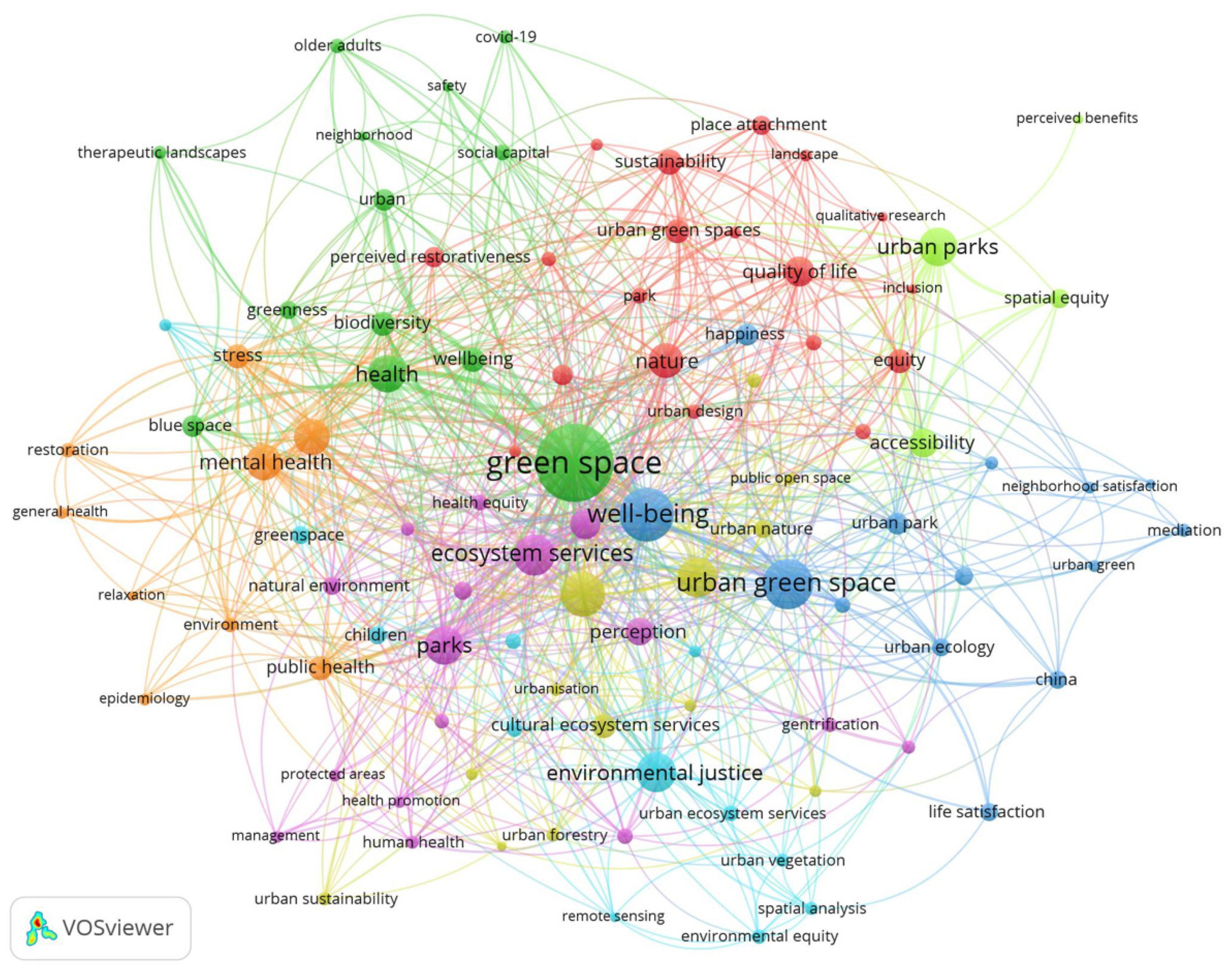
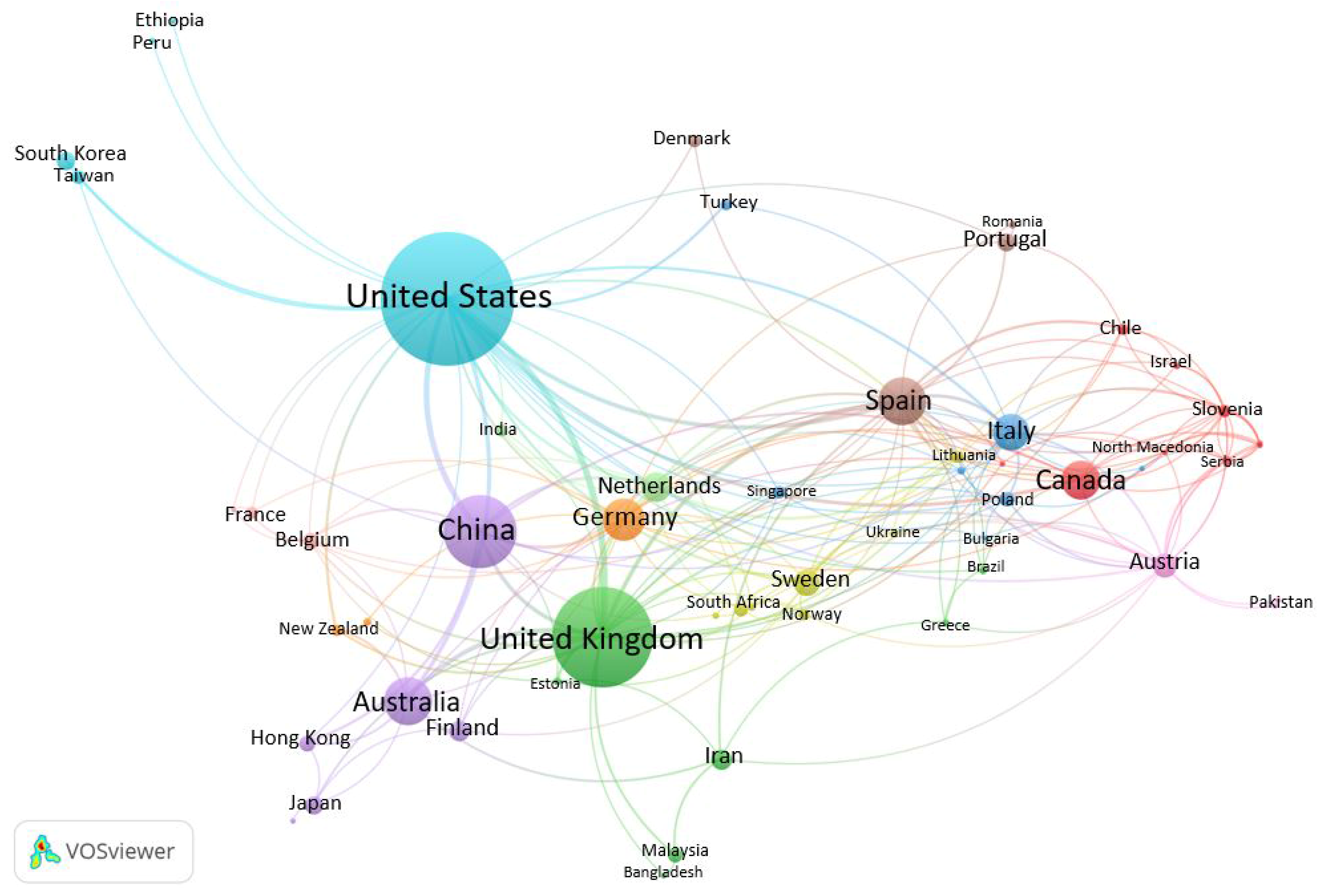
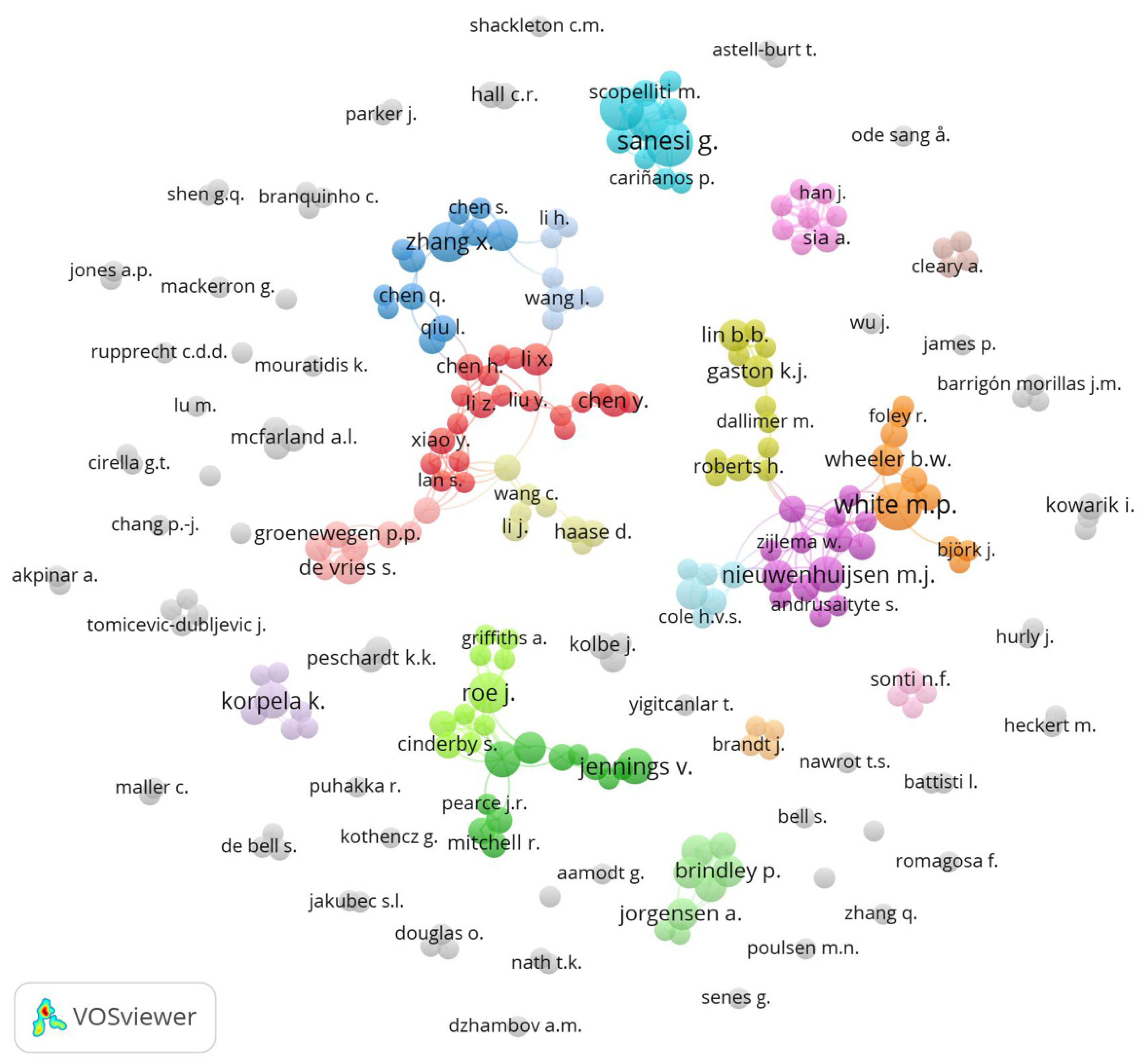
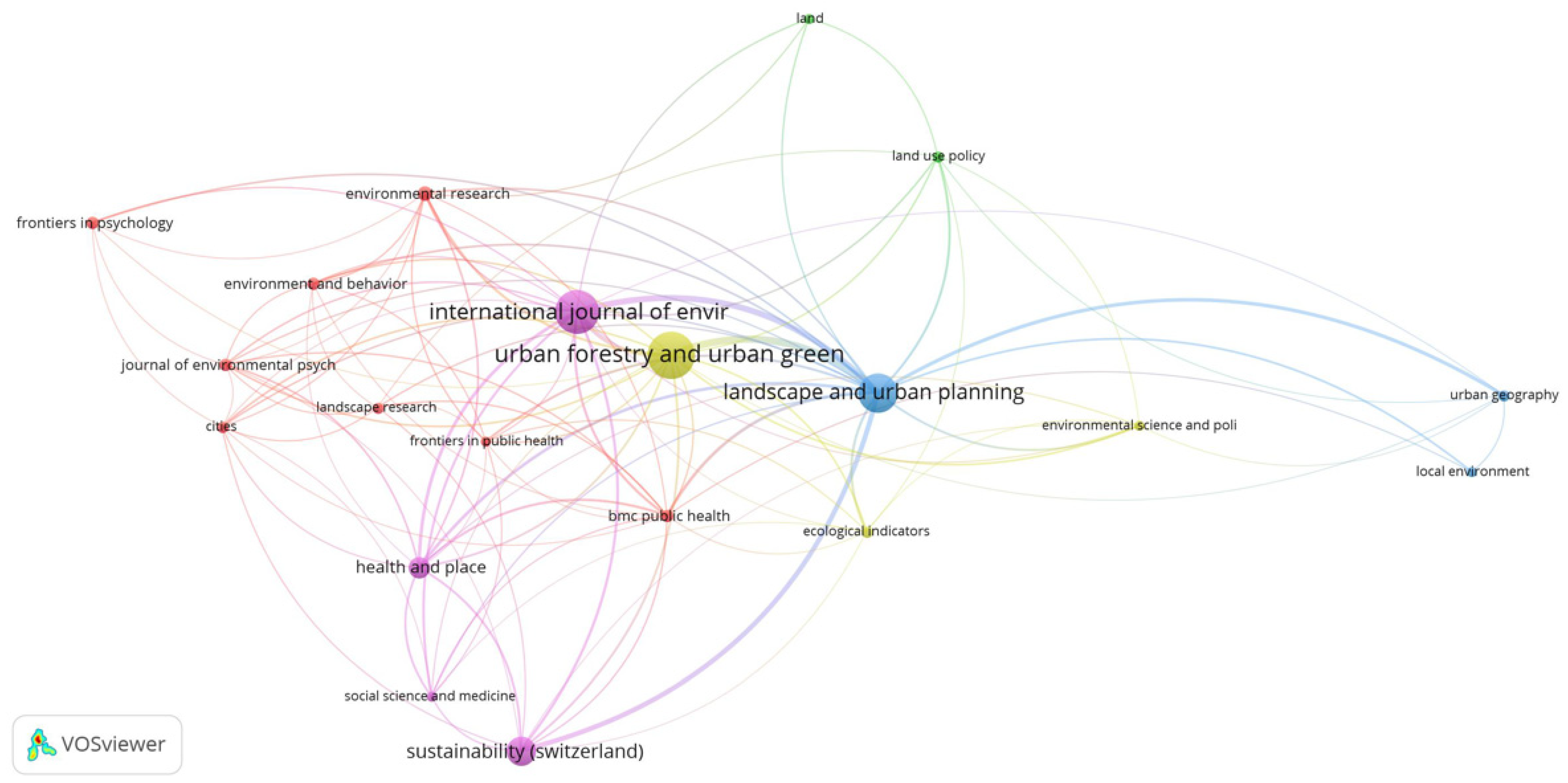
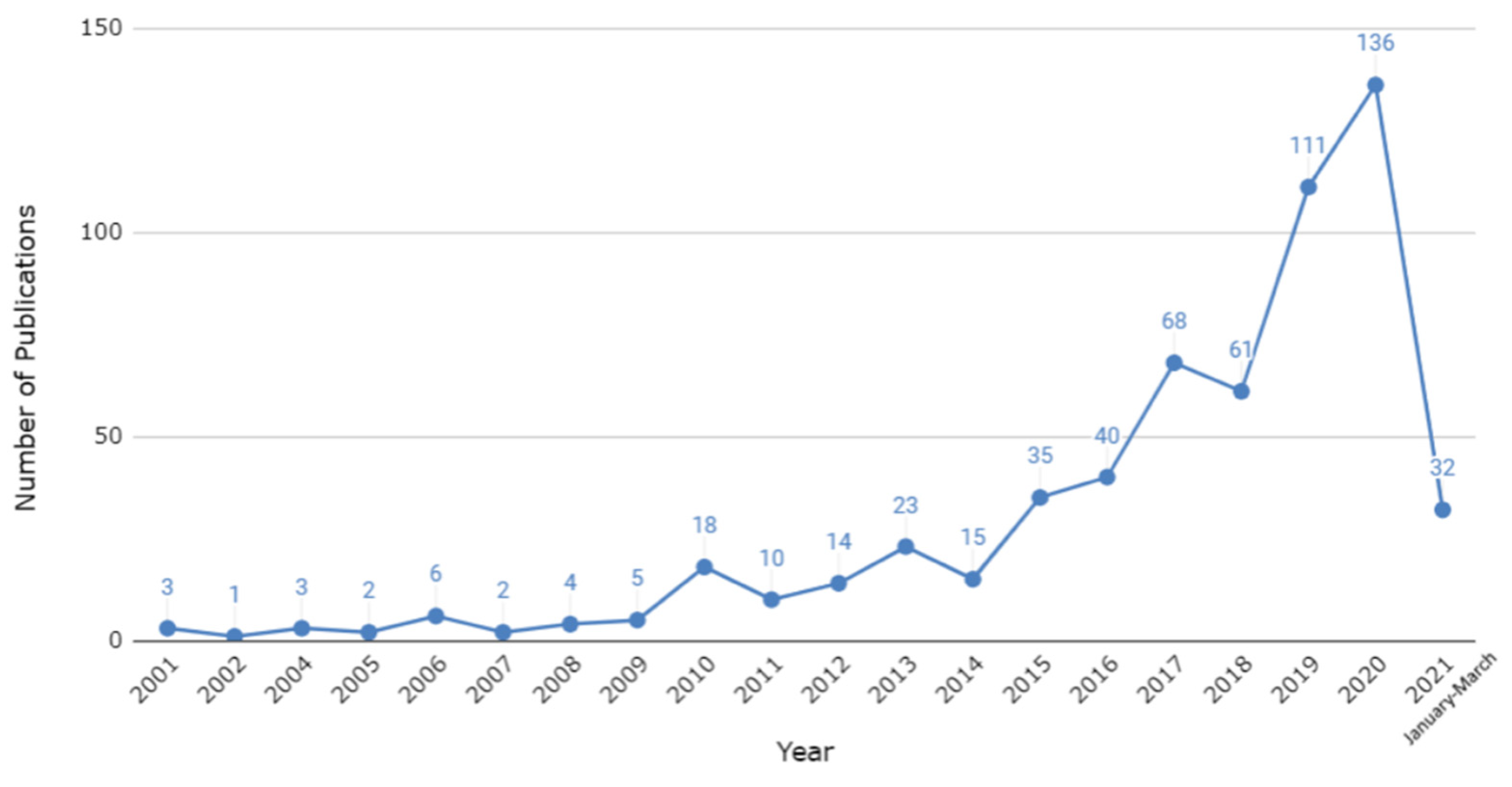
| Name of Author (Last, F.) | Number of Relevant Articles | Number of Times Cited |
|---|---|---|
| Sanesi, G. [31,32,42,43,44,45,46,47] | 8 | 721 |
| White, M.P. [48,49,50,51,52,53,54,55] | 8 | 666 |
| Carrus, G. [31,42,43,44,45,46,47] | 7 | 705 |
| Lafortezza, R. [31,32,42,43,44,46] | 6 | 704 |
| Roe, J. [56,57,58,59,60,61] | 6 | 269 |
| Brindley, P. [62,63,64,65] | 4 | 27 |
| McEwan, K. [62,63,64,65] | 4 | 27 |
| Richardson, M. [62,63,64,65] | 4 | 27 |
| Sheffield, D. [62,63,64,65] | 4 | 27 |
| Colangelo, D. [31,42,47] | 3 | 370 |
Publisher’s Note: MDPI stays neutral with regard to jurisdictional claims in published maps and institutional affiliations. |
© 2021 by the authors. Licensee MDPI, Basel, Switzerland. This article is an open access article distributed under the terms and conditions of the Creative Commons Attribution (CC BY) license (https://creativecommons.org/licenses/by/4.0/).
Share and Cite
Tirri, C.; Swanson, H.; Meenar, M. Finding the “Heart” in the Green: Conducting a Bibliometric Analysis to Emphasize the Need for Connecting Emotions with Biophilic Urban Planning. Int. J. Environ. Res. Public Health 2021, 18, 9435. https://doi.org/10.3390/ijerph18189435
Tirri C, Swanson H, Meenar M. Finding the “Heart” in the Green: Conducting a Bibliometric Analysis to Emphasize the Need for Connecting Emotions with Biophilic Urban Planning. International Journal of Environmental Research and Public Health. 2021; 18(18):9435. https://doi.org/10.3390/ijerph18189435
Chicago/Turabian StyleTirri, Christopher, Hunter Swanson, and Mahbubur Meenar. 2021. "Finding the “Heart” in the Green: Conducting a Bibliometric Analysis to Emphasize the Need for Connecting Emotions with Biophilic Urban Planning" International Journal of Environmental Research and Public Health 18, no. 18: 9435. https://doi.org/10.3390/ijerph18189435
APA StyleTirri, C., Swanson, H., & Meenar, M. (2021). Finding the “Heart” in the Green: Conducting a Bibliometric Analysis to Emphasize the Need for Connecting Emotions with Biophilic Urban Planning. International Journal of Environmental Research and Public Health, 18(18), 9435. https://doi.org/10.3390/ijerph18189435







